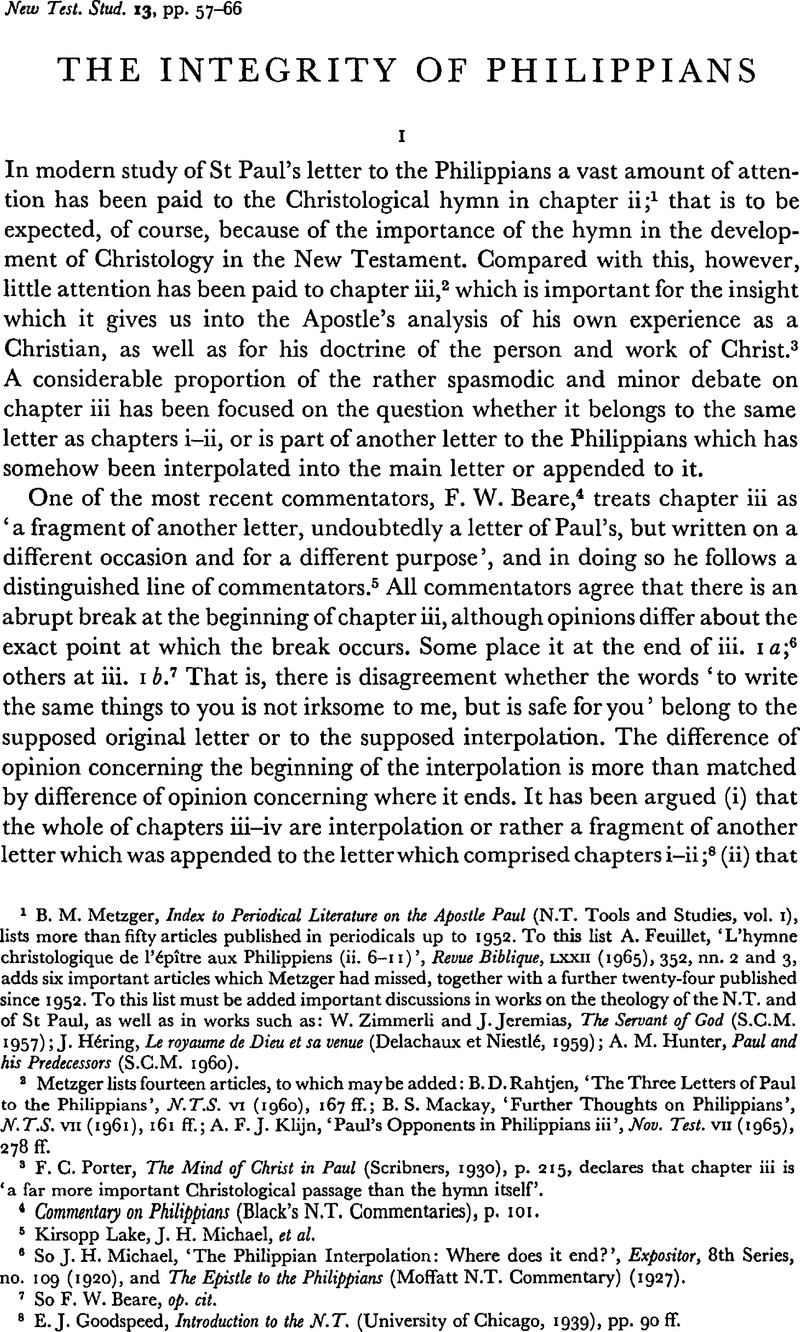Article contents
The Integrity of Philippians
Published online by Cambridge University Press: 05 February 2009
Abstract

- Type
- Short Studies
- Information
- Copyright
- Copyright © Cambridge University Press 1966
References
1 B. M. Metzger, Index to Periodical Literature on the Apostle Paul (N.T. Tools and Studies, vol. 1), lists more than fifty articles published in periodicals up to 1952. To this list A. Feuillet, ‘L'hymne christologique de l'épître aux Philippiens (ii. 6–11)’, Revue Biblique, LXXII (1965), 352, nn. 2 and 3, adds six important articles which Metzger had missed, together with a further twenty-four published since 1952. To this list must be added important discussions in works on the theology of the N.T. and of St Paul, as well as in works such as: Zimmerli, W. and Jeremias, J., The Servant of God (S.C.M. 1957)Google Scholar; Héring, J., Le royaume de Dieu et sa venue (Delachaux et Niestlé, 1959)Google Scholar; Hunter, A. M., Paul and his Predecessors (S.C.M. 1960)Google Scholar
2 Metzger lists fourteen articles, to which may be added:Google ScholarRahtjen, B. D., ‘The Three Letters of Paul to the Philippians’, N. T. S. vi (1960), 167 ff.Google Scholar; Mackay, B. S., ‘Further Thoughts on Philippians’, N.T.S. vii (1961), 161 ff.Google Scholar; Klijn, A. F. J., ‘Paul's Opponents in Philippians iiis’, Nov. Test. vii (1965), 278 ff.CrossRefGoogle Scholar
3 Porter, F. C., The Mind of Christ in Paul (Scribners, 1930), p. 215Google Scholar, declares that chapter iii is ‘a far more important Christological passage than the hymn itself’.
4 Commentary on Philippians (Black's N.T. Commentaries), p. 101.Google Scholar
5 Kirsopp Lake, J. H. Michael, et al.
6 SoGoogle ScholarMichael, J. H., ‘The Philippian Interpolation: Where does it end?’, Expositor, 8th Series, no. 109 (1920)Google Scholar, and The Epistle to the Philippians (Moffatt, N. T. Commentary) (1927).Google Scholar
7 So F. W. Beare, op. cit.
8 Goodspeed, E. J., Introduction to the N. T. (University of Chicago, 1939), pp. 90 ff.Google Scholar
1 So J. H. Michael, art. cit. and op. cit.
2 Rahtjen, B. D., art. cit., taking up the argument of J. E. Symes in Interpreter (January 1914).Google Scholar
3 Beare, op. cit. p. 4.
4 St Paul's Epistle to the Philippians, 12th ed. (Macmillan, 1903), p. 71.Google Scholar
5 The Epistle to the Philippians (Westminster Commentaries) (Methuen, 1918).Google Scholar
6 Ibid. Introduction, p. xlvii.
1 Art. cit. Michael criticized the arguments by which Jones supported his thesis, but did not completely demolish the thesis itself. The remainder of this article will seek to show that in fact Jones could have produced a much stronger case than he did.
2 Porter, F. C., op. cit. pp. 215 ff.Google Scholar, recognizes that there is a parallelism, but treats it as ‘not consciously worked out’ and ‘unintended’.
3 L'Épître de Saint-Paul aux Philippiens (Comm. du N.T.) (Delachaux et Niestlé, 1950).Google Scholar
4 Ibid. pp. 41 ff.; cf. also Feuillet, A., art. cit. pp. 361 ff.Google Scholar
5 Ibid. p. 66.
6 Ibid. p. 69.
7 It was Bonnard's triple use of dépouillement that led the present writer to investigate the possibility of parallelism between chapters ii and iii. Investigation led back to Michael's article, and thence to Jones's commentary.
8 The Epistle of Paul to the Philippians (Expositor's Greek Testament, 1910), p. 409.Google Scholar
9 B. S. Mackay, art. cit. p. 168.
1 Arndt, and Gingrich, , A Greek-English Lexicon of the N.T. (Cambridge, 1957).Google Scholar
2 Cf. Héring, J., op. cit. pp. 159 ff.Google Scholar; Martin, R. P., An Early Christian Confession (Tyndale, 1960), pp. ffGoogle Scholar
1 On the use of τò λοιπóν in the Pauline writings, cf. Moule, C. F. D., An Idiom-Book of N.T. Greek (Cambridge, 1953), pp. 161 f.Google Scholar
2 Op. cit. p. xlv.
3 Cf. Klijn, A. F. J., art. cit., for a fuller discussion of the identity of Paul's opponents.Google Scholar
4 Op. cit. p. xlv.Google Scholar
5 Ibid.
1 Cf. Héring, J., op. cit. pp. 159 ff.Google Scholar; Martin, R. P., op. cit. pp. 17 ff.Google Scholar; Higgins, A. J. B., Jesus and the Son of Man (Lutterworth, 1964), pp. 151 ff.Google Scholar
2 In Zimmerli, W. and Jeremias, J., op. cit. p. 97, n. 445.Google Scholar
3 Christology of the N.T. (S. C. M. 1959), pp. 77, 174 ff.Google Scholar Cullmann argues, as against Bultmann and his school, that the combination of the concepts goes back to Jesus himself.
4 Phil. ii. 10 has έξομολογήσηται, where the LXX has όμεīται the Greek version of Theodotion, however, has έξομολογήσηται.
1 Op. cit. p. xlvii.Google Scholar
2 It occurs also with the meaning ‘the manner of life I lived’ in Paul's speech before the council in Jerusalem in Acts xxiii. I (πεπολίτενμαι).
- 6
- Cited by


